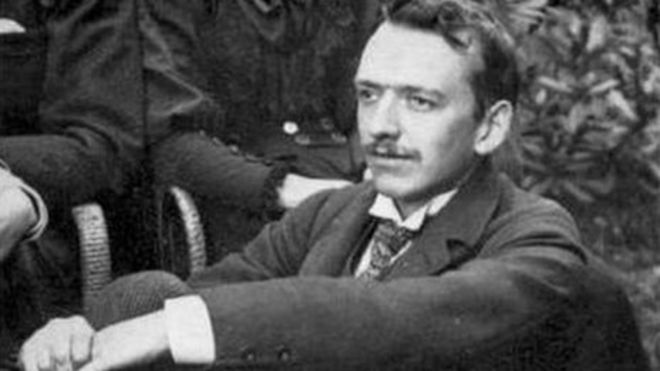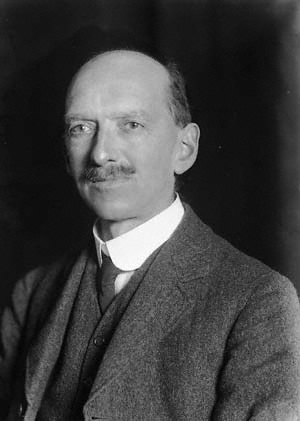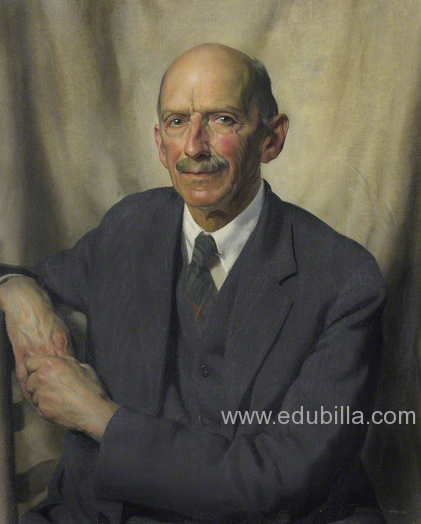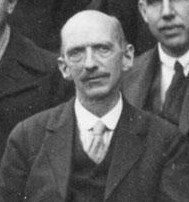Charles Thomson Rees Wilson
Charles Thomson Rees Wilson ( born February 14, 1869 Parish Glencorse, Scotland, † November 15, 1959 in Carlops in Edinburgh) was a Scottish physicist and Nobel laureate.
Life
Charles Thomson Rees Wilson was born the son of farmer John Wilson and his wife, Annie Clerk Harper in Glencorse Parish in the County of Midlothian in Edinburgh on 14 February 1869. After the death of his father in 1873 he moved with his mother to Manchester. After attending a private school he was at Owen 's College, now the University of Manchester, formed - 1888 he moved to the Sidney Sussex College, Cambridge, where he graduated in 1892. With the aim to become a doctor, he attended mainly courses in biology. At Cambridge, he began increasingly to be interested in physical and chemical problems - but his decision could turn away from medicine have been at Owen 's College, also influenced by Balfour Stewart, Professor of Physics.
After studying Wilson worked at the Cavendish Laboratory in 1900 and a Fellow of Sidney Sussex College, lectured and led before experiments. He took over 1918 the Advanced Lectures in Applied Physics at the Cavendish Laboratory. He was appointed in 1913 to the meteorological observer at the Observatory for Solar Physics at Ben Nevis. From 1918 he lectured in electrical meteorology and in 1925 was appointed Jacksonian Professor of Natural Philosophy.
Wilson married in 1908, the pastor's daughter Jessie Fraser and was the father of four children, two sons and two daughters. He died on 15 November 1959 in Carlops surrounded by his family.
Work
After the observation of coronas and glories at Ben Nevis in the late summer of 1894 he began to try to reproduce these phenomena in the laboratory. In his experiments with moist, dust-free air, he noted that very often took place a drop formation. After a few months he put on the presumption that it is a condensation of nuclei produced continuously - possibly ions, which are also responsible for the residual conductivity of the atmosphere. This assumption was confirmed in 1896 when he exposed a precursor of the cloud chamber the newly discovered X - rays, which led to a sharp (almost like rain ) increase in drop formation. In the following years, Wilson devoted extensive studies of ions as condensation nuclei, since 1900 his research, however, were severely limited due to his extensive teaching activities. He was able to capture the traces of individual alpha and beta particles ( electrons = ) photographically in 1911 with a further developed cloud chamber for the first time. In the following years this technology could evolve to perfection, which culminated in his two legendary, perfectly illustrated publications on the orbits of electrons in 1923. His technique has been applied in many parts of the world with great success, including Blackett and Kapitsa in Cambridge, by Irène Curie and Auger in Paris and by Bothe and Meitner in Berlin.
For the development of named after him, Wilson's cloud chamber to detect radioactive rays and other charged elementary particles, he and Arthur Compton, who could prove the Compton effect by means of a cloud chamber without a doubt, 1927 was awarded the Nobel Prize for Physics.
Awards
- Member ( "Fellow" ) of the Royal Society, 1900
- Hughes Medal of the Royal Society, 1911
- Hopkins Prize, Cambridge Philosophical Society, 1920
- Gunning Prize, Royal Society of Edinburgh, 1921
- Royal Medal of the Royal Society, 1922
- Howard Potts Medal, Franklin Institute, 1925
- Nobel Prize in Physics, 1927
- Copley Medal, Royal Society, 1935
The lunar crater Wilson is named after him as well as the Scottish astronomer Alexander Wilson and the American astronomer Ralph Elmer Wilson.










